The truth is that I wouldn't know which one to choose if I had to pick just one of his designs, and I'm sure that -probably without knowing it- you've dreamt of more than one of his designs... Did you know that Gandini invented the "scissor" doors of the Lamborghini, which debuted on his Carabo concept car? Good design doesn't start with looking for beautiful shapes, but in the end, beauty is inherent in good design, so it's not surprising that in 2009 when Robert Cumberford interviewed him, Gandini told him that "What interests and motivates me most is the architecture of the car, its construction, assembly and mechanisms, not its appearance".
Gandini and Bertone
Some gossip has it that when Gandini knocked on Bertone's door in 1963 to ask for a job, Giugiaro (then Head of Design at Bertone) turned him down. True or not, it is curious that when Giugiaro was asked a few years ago about his favorite designs, he answered that one of them was the Renault Supercinco, designed by Marcello Gandini, giving all the details of why he liked it so much.
It is generally agreed that Gandini's most fruitful period began in 1965 when he finally joined Bertone, taking the position vacated by Giugiaro when he left for Ghia. Gandini worked for Bertone from 1965 to 1980, creating the Style Bertone division, of which he was General Manager. In 1980 he left Bertone to start working on his own as an industrial designer, working on interior design, architecture, the styling of the Heli-Sport CH-7 helicopter... Nowadays, some rumours claim that he is currently working for Tata...
This is the list of designs attributed to Marcello Gandini, as always, I'm sure that many designers also worked on them, contributing ideas, and I'm sorry that they don't receive the right recognition. If you have any information on this, I would be grateful if you could let me know:
- 1966 Lamborghini Miura
- 1967 Bertone Jaguar Pirana
- 1967 Lamborghini Marzal
- 1968 Alfa Romeo 33 Carabo
- 1968 Lamborghini Espada
- 1969 Iso Lele
- 1969 Autobianchi A112 Bertone Runabout
- 1970 Alfa Romeo Montreal
- 1970 Lamborghini Jarama
- 1970 Lancia Stratos Zero
- 1972 Lancia Stratos
- 1972 Lamborghini Urraco
- 1972 BMW 5 Series
- 1972 Fiat 132
- 1972 Fiat X1/9
- 1973 Ferrari Dino 308GT4
- 1974 Lamborghini Bravo
- 1974 Lamborghini Countach
- 1974 Maserati Khamsin
- 1974 Maserati Quattroporte II
- 1979 Volvo Tundra
- 1980 Renault 5 Turbo
- 1982 Citroën BX
- 1984 Renault 5 Supercinco
- 1987 Maserati Biturbo (facelift)
- 1990 Maserati Shamal
- 1990 Maserati Chubasco
- 1990 Bugatti EB110
- 1990 De Tomaso Pantera SI
- 1990 Lamborghini Diablo
- 1990 Renault Magnum (truck)
- 1991 Maserati Biturbo (facelift)
- 1991 Iso Grifo 90
- 1992 Maserati Ghibli II
- 1991 Cizeta-Moroder V16T
- 1994 Maserati Quattroporte IV
- 1996 Iso Grifo 96
- 2000 De Tomaso Biguà (Qvale Mangusta)
And now comes the difficult part; having to choose some of his designs to comment them... I'm not going to order them by importance, but by chronological order, which I think is more illustrative.
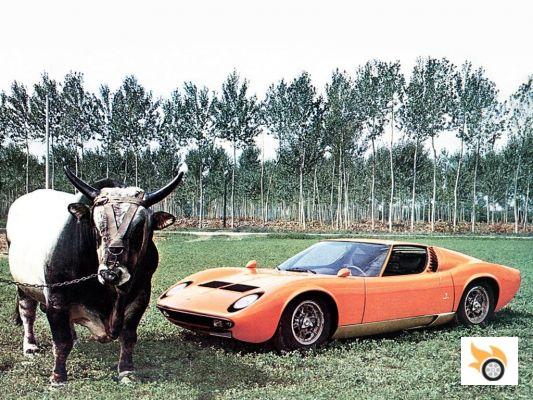
Lamborghini Miura (1966)
Little can be said about the Lamborghini Miura that hasn't already been said. Just remember that it was developed by Lamborghini engineers in their spare time, as Ferruccio Lamborghini was more interested in GTs than in extreme sports cars. Its transverse mid-engine V12 architecture - unheard of in road cars - made it the first mid-engine supercar in history, and the fastest road car at the time.
It is said that when Bertone saw the chassis at the 1965 Turin Motor Show, he begged Ferruccio Lamborghini to commission him to design it, because the chassis and architecture allowed for proportions never before seen in a road car. It was the first important work of a very young Gandini who designed it in only three months... and he did it brilliantly.
In my opinion, its beauty lies mainly in its proportions, and in the incredible way Gandini adjusted the forms and language to the architecture and technique of the car. Gandini was right not to exaggerate the curves. The aim was to keep the waistline as low as possible, and it is clear that Gandini wanted an elegant design that was as low and restrained as possible, without unnecessary volumes. This was helped a lot by the innovative and somewhat strange folding headlights, which allowed to keep the front wheel arches very low, with just the right volume and curvatures.
The air intakes in the doors are simply brilliant, very discreet, but at the same time provocative, and perfectly functional. Together with the rear side panels, they form a very innovative and coherent whole, making it clear which area of the car provides the power. The rear grille is also a perfect solution, as it visually lightens the area, provides ventilation to the engine, and warns the viewer that there is an engine inside that occupies all the available space... Overall, the Miura is one of the most incredible expressions of the beauty that an object can achieve when a genius combines form and function in the most masterful way possible.
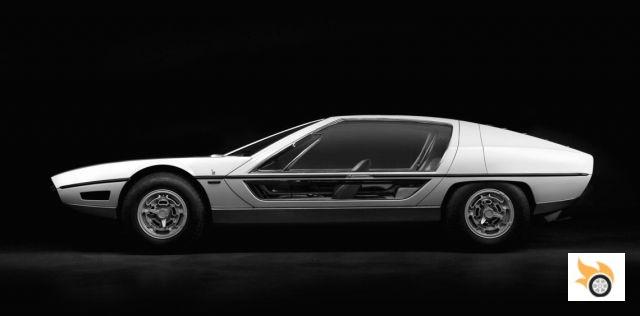
Lamborghini Marzal (1967)
It may not look like it today, but at the time, the Marzal was more like a spaceship on wheels than a car. The four-seater coupe with a rear engine (a V6 that resulted from cutting the engine of a Miura in half), with its extravagant glazed gull-wing doors, reinforced with its lines the spectacular and very low architecture, which must have pleased Don Ferruccio, as it inspired the later Espada.
I was able to see it a few years ago in its natural state, and I must say that in its natural state it is even more captivating.
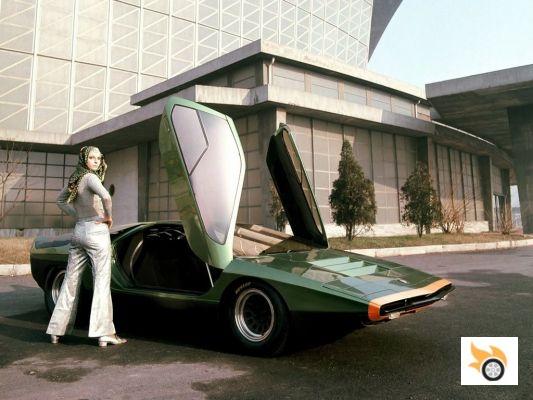
Alfa Romeo Carabo (1968)
The Carabo is considered one of the most influential concept cars in history. It was the forerunner of the wedge-design that influenced many later prototypes and sports cars, and even today still inspires some of the most spectacular sports cars.
Apart from its innovative silhouette and proportions, it provided a provocative aesthetic language, with an image that reflected speed and efficiency, but by no means elegance. There are no gratuitous and sensual shapes, all the elements have forms that adapt to the function, and even its metallic green color that contrasts with black areas, and its rear painted in lime green announce us that its image does not pretend to please the observer...
A detail that not everyone knows is that it was the first car with the famous scissor doors.
Maybe not the most beautiful, but one of the most important concept cars in history, and it was always Nuccio Bertone's favourite.
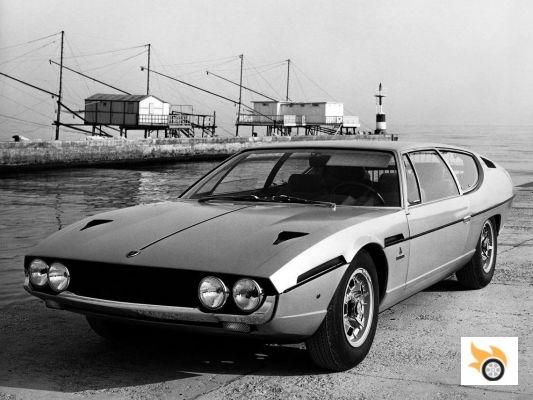
Lamborghini Espada (1968)
With such a low engine, which allowed a low and wide bonnet, it would have been easy to design an elegant and stylish 2+2, one of those that everybody likes. But Lamborghini wanted something different, a car with character, and Gandini designed a car inspired by the Marzal, with bold proportions, and lines that underlined the low profile of the car, and with the strangest rear end ever seen in luxury cars. Don't you like it? Maybe it's because you haven't seen it live yet?
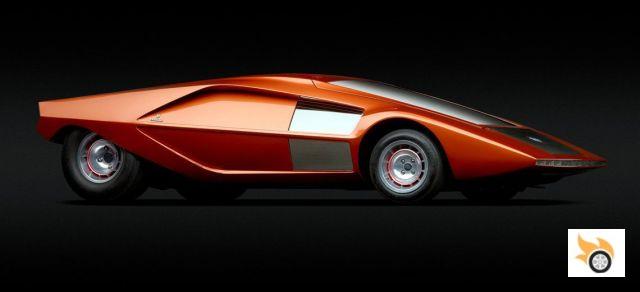
Lancia Stratos Zero (1970)
This concept car was designed and built by Bertone to attract the attention of Lancia, and get a contract that would allow it to manufacture a mid-engined sports car for the Italian brand, which at the time preferred to work with Pininfarina. The idea was to develop a rear-engined coupé prototype that could compete with the - by then successful - Alpine rally cars. Lancia wasn't too receptive, but Nuccio Bertone was determined to convince them, bought a second-hand Fulvia, and commissioned Gandini to design a mid-engined sports car around the Fulvia's small 1.6 V4...
But once Gandini sat down at the drawing board, he took the idea to extremes no one could have suspected. Gandini designed an absolutely radical and minimalist packaging, with the Fulvia engine in the rear position, and the radiators between the engine and the passenger compartment. The driver and passenger had access to the cabin through the windshield, and were practically lying down... which allowed an incredible height of only 840 mm and the length remained at 3,58 m.
In nature, the car is absolutely stunning for its proportions and dimensions, but also, the design of the ribs on its sides, its rear windows, the way in which the different planes of the body intersect... It is perhaps one of the cars that comes closest to being described as a work of art for its sculptural and seemingly whimsical forms, but at the same time, impeccably functional.
Undoubtedly, one of the most incredible, daring and innovative designs in history, which marked proportions and language that still remain in today's supercars.
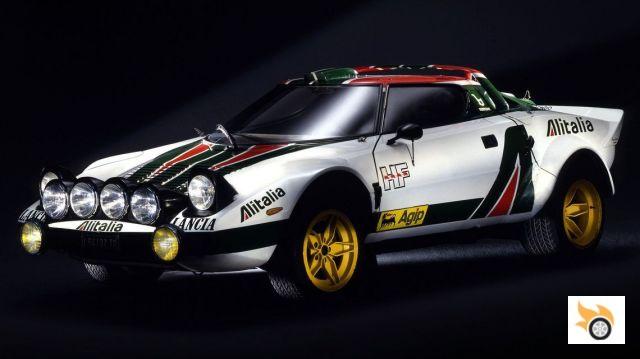
Lancia Stratos (1972)
Without the Stratos Zero, there would have been no Lancia Stratos rally car. The aim of Bertone's prototype was not to win the World Rally Championship, but it gave the idea to Cesare Fiorio. As soon as the young Lancia rally team manager saw the Stratos Zero, he started thinking about building a car specifically designed for rallying (something no one had ever done before) and then making just the 500 units needed for homologation. It seemed crazy, but as Guille Alfonsin told us in his article dedicated to the Stratos, the stubbornness of Bertone, the power of conviction of Fiorio, and a surplus of Ferrari V6 engines that were not going to be used (at that time, it was decided to cease production of the Dino), convinced the top of Fiat to go ahead with the project of what is perhaps the best rally car in history, and certainly the best designed.
Gandini was always a fan of engineering, and an advocate of the principle that form should follow function. He worked closely with Fiorio and engineer Gianpaolo Dallara to first define the packaging of the car, and then to adapt its design to the needs of a rally car, with doors with holes for helmets, a front and rear that could be completely dismounted to allow good access, a panoramic windscreen that allowed maximum visibility...
The aesthetic language was partly inspired by the Stratos Zero, but the spectacular proportions and shapes were dictated directly by function, which is probably why it is so fascinatingly beautiful. It's a car that motoring enthusiasts are passionate about, and that must be because when we see it, it conveys efficiency, speed, and makes us think of the mix of challenge and adventure that is any rally section. It is not an elegant car, but rally cars are not, its beauty is that of an efficient and perfect machine.
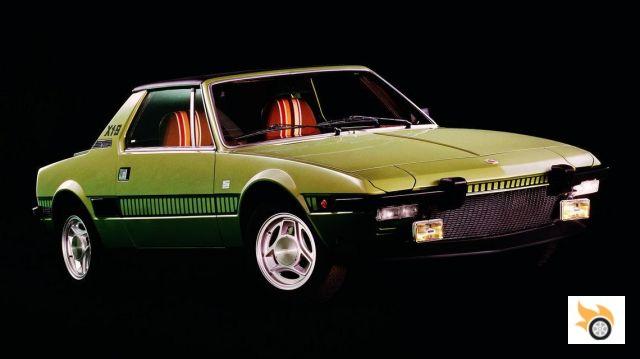
Fiat X1/9 (1972)
I admit it, when I was young I dreamed of owning a Fiat X1/9, and if I had room (and a bit more money) I would have one in my garage, and preferably in green...
In 1969, Bertone presented the Runabout concept car (also designed by Gandini) with Autobianchi A112 mechanics in central position, with the aim - as almost always in Bertone - of getting a contract for the production of small series. The idea did not convince Autobianchi, but it inspired Fiat, who thought of a successor to the 850 Spider.
The wedge-shaped silhouette, which rises in a single stroke up to the roll-over arch area, to descend again towards the rear, reminds me of the Stratos Zero and the Lancia Stratos, forming a sort of triangle with unequal sides. The forward-slanting roll-bar at the apex of this triangle gives strength and character to this area, and the rest of the car is an ode to simple, functional geometric shapes.
The whole is incredibly light visually and has the grace of the essential and easy to remember designs, cars that I never get tired of drawing again and again... The side ribbing, the nice and tidy rear light clusters, the black cover over the engine that suggests power... The only downside that can be put in terms of design are the abominable bumpers of the US version that almost hurt to look at.
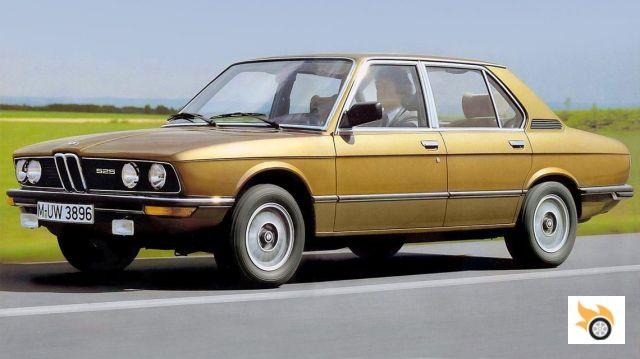
BMW 5 Series (1972)
The 5 Series (E12) was one of those epoch-making cars that influenced a whole generation of BMW cars, with design details that live on in today's BMWs.
But when it comes to talking about its designer, it is a car that -at least- has three fathers, since the design that Gandini (who worked for Bertone) presented to BMW was clearly inspired by the beautiful BMW Garmish prototype by Bertone and on the other hand, Paul Bracq (who worked for BMW) retouched Gandini's design, so that some sources attribute the design of the 5 Series to Paul Bracq...
Be that as it may, the styling and language of the BMW 5 Series can also be seen in other Gandini designs, such as the Maserati Quattroporte 2.
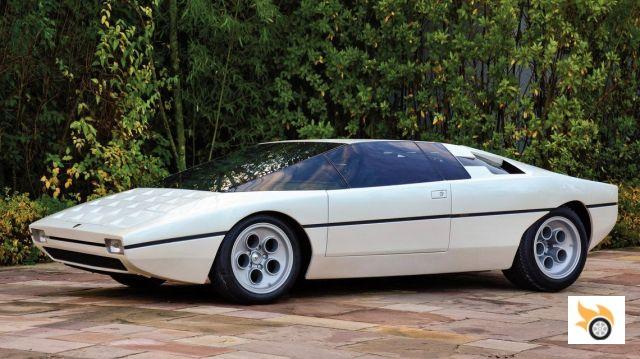
Lamborghini Bravo (1974)
The Bravo was designed as a two-seater version of the Urraco (no, I haven't forgotten about it, I just had to cut somewhere so that this article didn't turn into an encyclopedia) and this time Bertone developed a fully functional prototype, which was even used for road tests for tuning, and built a second unit that passed crash tests. Lamborghini eventually scrapped the project due to its then delicate financial situation, and Bertone even considered a variant with the 1.5-litre turbocharged X1/9 engine, which was also discarded when Fiat announced it was discontinuing that engine.
It's not that the Bravo is an unknown, but in my opinion, it has more importance than it is acknowledged, as it anticipated much of the language and proportions that later made the Countach famous. The Bravo boasts a simple and geometric silhouette, very clean, and the geometric play of its surfaces, basically flat, seems to me particularly inspired, and inspired many other later designs.
The prismatic shapes of the whole ensemble, and the way in which the glazing intersects them at the front, are so apparently simple that they are surprisingly harmonious, so they will never go out of fashion. And the very "mechanical" design of the air inlets and outlets reminds us once again that Gandini always designed with function in mind.
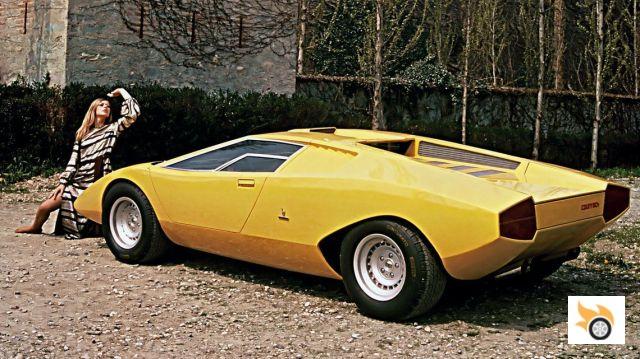
Lamborghini Countach (1974)
If there is one example in the history of the automobile in which the successor model is absolutely and radically different aesthetically from its predecessor, this is the Miura-Countach case. But it is even more remarkable that both have gone down in history as design masterpieces.
When Gandini started to work on the successor of "his" Miura, he had already been designing cars with a wedge silhouette and geometric shapes that had nothing to do with the Miura, but in spite of this, the Countach prototype surprised the public by the turn of the screw that its design represented.
One detail that perhaps goes unnoticed, and which suggests that Gandini wanted his Countach to have some connection with the Miura, is the waistline and side view of the prototype presented in Geneva in 1971. Maybe it's just me, but the clean side panels, which are bounded above by an elegantly sinuous beltline, remind me a bit of the Miura.
Without abandoning the prismatic design of its later designs, the Countach prototype gently curved some surfaces, and was much less aggressive and brutal than the production Countach.
The design was well received, and curiously, Lamborghini used the prototype (which was functional) to evolve it and define the production version, and soon discovered the shortcomings in terms of engine ventilation, so the side intakes were added, the upper intakes were raised behind the windows, the radiators were rotated ... What was a beautiful show car, became a test mule, and was finally used to pass a crash-test, and disappeared.
Again, form had to follow function, and the "functional" additions transformed the production model into a much more cluttered and brutal car, and although it lost some of the beauty of the prototype, the air intakes, and the new rear light clusters (which looked like a temporary addition) gave it the brutal and industrial character that made it an icon.
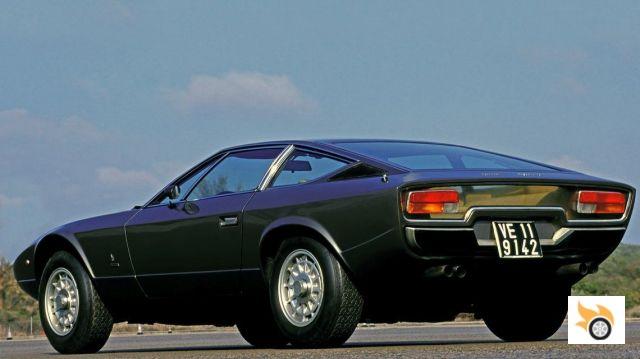
Maserati Khamsin (1974)
Developed during the period when Citröen owned Maserati, the Khamsin represented the Italian coachbuilder's first work for the French marque. The Khamsin replaced the successful Giugiaro-designed Ghibli, and as a GT, it had no immediate replacement.
The car has a very simple and elegant design, and is dotted with some genius, such as the asymmetrical grilles on the bonnet (again functionality and Gandini) and above all, the rear glass panel on which the rear light clusters "float", and which greatly improves rear visibility. Gandini wanted a light image, and for that reason, he designed some false rear grilles behind the rear windows, which lightened that area, and hid the refuelling nozzle.
In addition to the original rear view, it would highlight the marked ribbing of the beltline, which forms a gentle undulation, and that ends in the rear atypically, pointing "upwards". This ribbing (familiar in Gandini) is not an added motif to give rhythm, but in fact, marks the character of the car, and forces a very steep side windows.
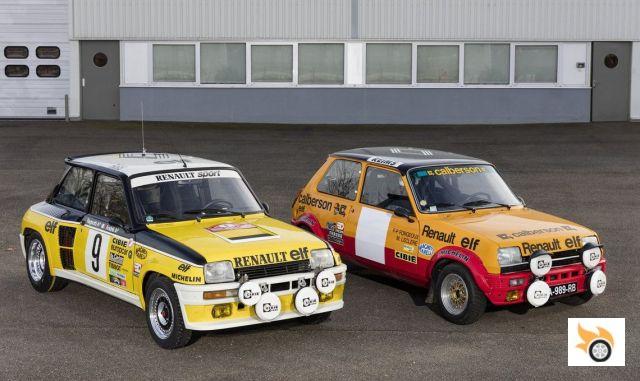
Renault 5 Turbo (1980)
The Renault 5 Turbo project, which like the Stratos, was born with the aim of designing a car designed exclusively for competition, was driven by Jean Terramorsi of Reanult, and the first design was made by Marc Deschamps of Bertone, designing a mid-engined car based on the R5, although with very different aesthetics. Terramorsi, who was delighted with the idea, died soon after, and Henry Lherm succeeded him in the position, betting on continuing the project.
The final design was the responsibility of Gandini, who once again proposed a function-based design, which modified the bodywork in such a way that it was clear that the base car was an R5 with a "fat" engine in the back. Gandini worked closely with the engineers who developed the car, to achieve a tremendously effective packaging, which he reflected in the exterior design.
The idea and the design were a success, the design was loved by the fans, and the fact that the car was clearly identified as an R5 was a boost to the image of the model and the brand, a boost in image that a coupe with a very distinct aesthetic would not have provided.
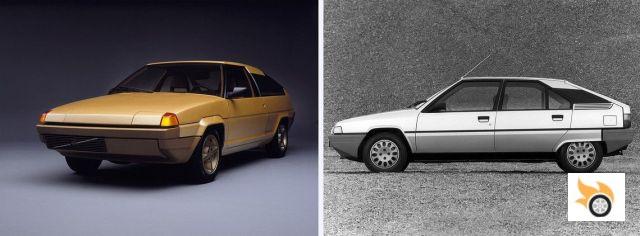
Volvo Tundra / Citröen BX (1982)
The Volvo Tundra with its innovative design was Bertone and Gandini's idea for the successor to the Volvo 262C. With the Tundra, Gandini once again showed his creativity with the Tundra, a car with an absolutely new language, the design was way ahead of its time, and its lines full of rationality, with glazed surfaces that did not respect the standards of the time.
The design was rejected by the then conservative Swedish firm, but Gandini believed in it, so when Citröen commissioned a design for the successor to the GS/GSA, Gandini made the necessary modifications to turn it into a five-door family car, and to rationalize its inductrialization, and the Citröen BX was born, a design way ahead of its time, and despite the "square" of some of its surfaces, tremendously aerodynamic... In fact, they say that NASA bought one and took it to its facilities in the USA to analyze how an object that seemed to be an object that could be a "aerodynamic" car could be used in the US.UU. to analyze how an object apparently so little aerodynamic, could have a CX of 0.31...
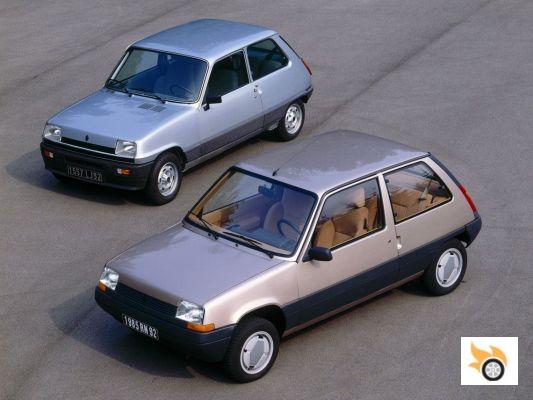
Renault Supercinco (1984)
After Renault's own design department had spent some time working on the replacement for its successful R5 without coming up with any ideas that the management was in love with, the decision was made to hire the designer in vogue at the time, and Gandini was asked to preserve the styling of the R5's then-novel integral bumpers.
Structurally, the Supercinco would use part of the R9/11 platform, which meant that the engine would move from the old-fashioned longitudinal position (inherited from the R4) of the R5 to the modern transverse layout of its competitors. The new layout improved not only handling, but also livability.
Gandini must have really liked Michel Bouè's original design of the "old" R5, because his Supercinco was almost a homage to the predecessor model. Gandini was very respectful with all the elements that gave personality to the R5: silhouette, light clusters, rear slope, taillights, low and peripheral beltline... and he did an incredible detail work, making all the elements fit perfectly. Especially attractive is the way the fenders surround the whole car in a very elegant way, and the solution at the rear. Gandini also thought about making the car pleasant to drive, designing a glazing that provided luminosity, and very good visibility in all directions (something that more and more, modern cars lack).
I remember that when the model appeared, I was particularly struck by the clean lines, very relaxed and polished, although to tell the truth, I never managed to understand the piece of plastic that was located under the front grille, just between the indicators.
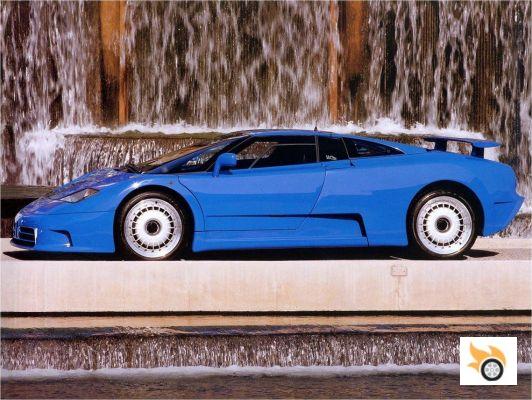
Bugatti EB110 (1990)
Perhaps the Bugatti EB110 deserves an article by itself because of its exceptional engineering, so I'll just remember that the project was born from the will of the tycoon RoMano Artioli to revive the brand, and that to design and build what he wanted to be the best sports car in the world, he hired Paolo Atanzani and Nicola Materazzi as engineers, and Marcelo Gandini for the styling, and that, among other refinements, it was the first production car with carbon fiber monocoque.
Gandini, always very attentive to packaging and engineering, designed a bodywork with few concessions to the gallery, but with a strong personality. The whole is very compact, and was developed in Pininfarina's wind tunnel. It is a very compact car, which seems to announce that "there is no more room for power and technical sophistication here". The front light clusters, which seem to be placed where there was a gap, are significant, but I love them. It's one of those cars that maybe you can't call beautiful, but it's fascinating.
On the other hand, the connection to Bugatti history may seem to be limited to the blue bodywork, the horseshoe in the grille, and the Bugatti Royale-inspired wheels, but the whole design of the car has the simple curved surfaces of the Bugatti of old.
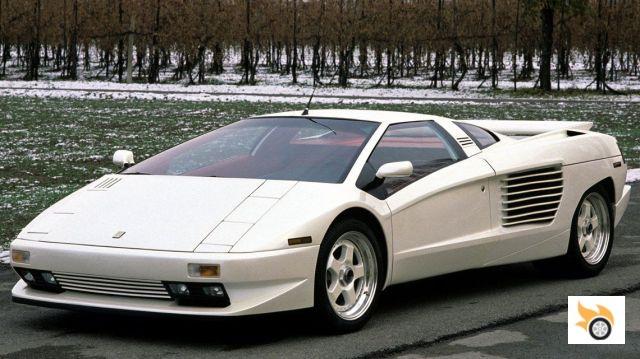
Cicetta Moroder V16-T (1991)
By now, you may have noticed that I "forgot" to put the photo and comment on the design of the Lamborghini Diablo... No, actually, I forgot to comment on the design of the Diablo, because the management of Chrysler (then owner of Lamborghini) decided to modify and soften the original design of Gandini, who when he saw the final result, was very disappointed.
On the other hand, you might have found some similarities between the Cicetta and the Diablo... When Claudio Zampodi, owner of Cizetta, contacted Gandini, both agreed to base the design of the V16-T on the original prototype for the Diablo, so, except for the rear area, where Claudio Zampodi himself suggested modifications, we could say that the Cizetta is the Diablo that Gandini would have wanted.
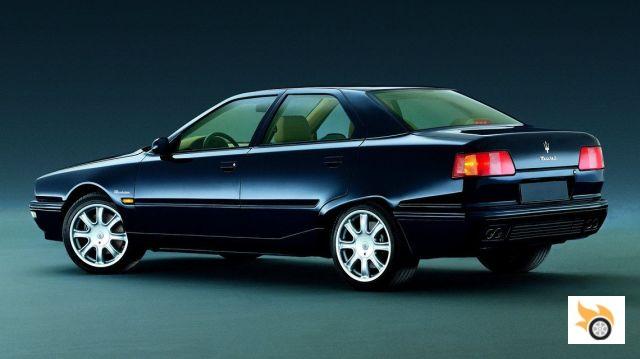
Maserati Quattroporte 4 (1994)
The Quattroporte 4 was the last Maserati to be developed before Ferrari took control of the trident company, and Gandini designed a car that was smaller than its predecessor, making it look like Maserati wanted to rival the range-topping versions of the BMW 5 Series.
The Quattroporte 4's design is tidy, boasting a spectacular 0.31 CX. The overall design is wedge-shaped, with a tall, solid rear end that oozes character. Particularly interesting to me are the rear light clusters, and how the bizarre rear mudguards (reminiscent of the Countach) are visually extended by an edge towards the rear, lightening the rear in its lower area. An imaginative and interesting solution.
A design that may not impress at first, but that never tires, and that will never go out of fashion.
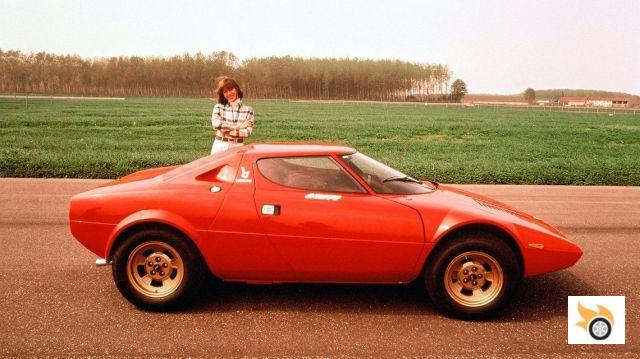
Although Marcello Gandini continued to produce great designs after leaving Bertone, it is clear that his most fruitful period was the one he spent at Bertone. Although Gandini himself always considered that a car could never be a work of art, and claims to be more interested in technical design than styling, I think we can consider him an artist, and all artists have exceptionally fruitful periods.
However, we cannot forget that during his time at Bertone he was supported by other designers, designers who - without a doubt - contributed invaluable ideas, ideas which, together with Gandini's, resulted in an impressive collection of masterpieces.
Master Marcello Gandini, thank you very much for giving us so much design and beauty.

























